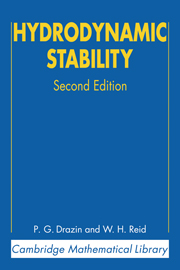Book contents
- Frontmatter
- Contents
- Foreword by John Miles
- Preface
- 1 INTRODUCTION
- 2 THERMAL INSTABILITY
- 3 CENTRIFUGAL INSTABILITY
- 4 PARALLEL SHEAR FLOWS
- 5 UNIFORM ASYMPTOTIC APPROXIMATIONS
- 6 ADDITIONAL TOPICS IN LINEAR STABILITY THEORY
- 7 NONLINEAR STABILITY
- APPENDIX: A CLASS OF GENERALIZED AIRY FUNCTIONS
- Addendum: Weakly non-parallel theories for the Blasius boundary layer
- Solutions
- Bibliography and author index
- Motion picture index
- Subject index
1 - INTRODUCTION
Published online by Cambridge University Press: 06 August 2010
- Frontmatter
- Contents
- Foreword by John Miles
- Preface
- 1 INTRODUCTION
- 2 THERMAL INSTABILITY
- 3 CENTRIFUGAL INSTABILITY
- 4 PARALLEL SHEAR FLOWS
- 5 UNIFORM ASYMPTOTIC APPROXIMATIONS
- 6 ADDITIONAL TOPICS IN LINEAR STABILITY THEORY
- 7 NONLINEAR STABILITY
- APPENDIX: A CLASS OF GENERALIZED AIRY FUNCTIONS
- Addendum: Weakly non-parallel theories for the Blasius boundary layer
- Solutions
- Bibliography and author index
- Motion picture index
- Subject index
Summary
Yet not every solution of the equations of motion, even if it is exact, can actually occur in Nature. The flows that occur in Nature must not only obey the equations of fluid dynamics, but also be stable.
– L. D. Landau & E. M. Lifshitz (1959)Introduction
The essential problems of hydrodynamic stability were recognized and formulated in the nineteenth century, notably by Helmholtz, Kelvin, Rayleigh and Reynolds. It is difficult to introduce these problems more clearly than in Osborne Reynolds's (1883) own description of his classic series of experiments on the instability of flow in a pipe.
The … experiments were made on three tubes …. The diameters of these were nearly 1 inch, ½ inch and ¼ inch. They were all … fitted with trumpet mouthpieces, so that the water might enter without disturbance. The water was drawn through the tubes out of a large glass tank, in which the tubes were immersed, arrangements being made so that a streak or streaks of highly coloured water entered the tubes with the clear water.
The general results were as follows:–
(1) When the velocities were sufficiently low, the streak of colour extended in a beautiful straight line through the tube, Fig. 1.1 (a).
(2) If the water in the tank had not quite settled to rest, at sufficiently low velocities, the streak would shift about the tube, but there was no appearance of sinuosity. […]
- Type
- Chapter
- Information
- Hydrodynamic Stability , pp. 1 - 31Publisher: Cambridge University PressPrint publication year: 2004

